|
 Camarophyllus patinicolor Camarophyllus patinicolor
SynonymsHygrocybe patinicolor
BiostatusPresent in region - Indigenous. Endemic
Images (click to enlarge)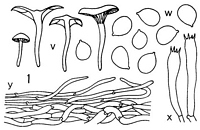
Caption: Camarophyllus patinaecolor Hk. (type): v. carpophores. - w. spores. - x. basidia. - y. cuticle | 
Caption: Fig. 18 Camarophyllus patinaecolor Horak. (G- K: PDD 27072,type): G. basidiomes. H. spores. K. basidia (ZT921): L. basidiomes. | 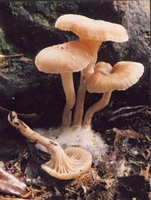
Caption: Camarophyllus patinaecolor
Owner: Kaimai Bush | 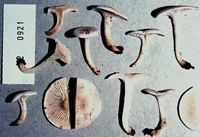
Caption: ZT0921
Owner: E. Horak: © Creative Commons Attribution-Noncommercial 3.0 New Zealand | 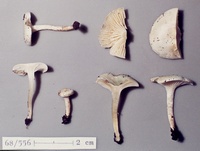
Caption: ZT68-556, Holotype
Owner: E. Horak: © Creative Commons Attribution-Noncommercial 3.0 New Zealand | 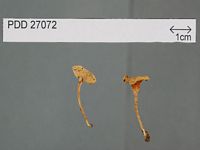
Caption: Dried type specimen
Owner: Herb PDD |
Article: Horak, E. (1990). Monograph of the New Zealand Hygrophoraceae (Agaricales). New Zealand Journal of Botany 28(3): 255-306 (http://www.rsnz.org/publish/abstracts.php).
Description: Pileus -35 mm, convex becoming umbonate-plane to expanded, finally centre depressed
or with low but distinct umbo, margin strongly inrolled in young specimens,
non striate; whitish to pale argillaceous with pale blue-green tinge (especially
obvious in aged specimens); dry, glabrous to minutely felty, not hygrophanous.
-Lamellae 12-22 (1-3) decurrent to arcuate, not anastomosing; whitish to pallid,
edges concolorous, entire. - Stipe 12-35 x 1-3 mm cylindrical, gradually tapering
towards base; concolorous with pileus; dry, glabrous, solid becoming fistulose,
single. –Context whitish to pale brown, soft. - Odour and taste not distinctive
or slightly unpleasant. - Chemical reactions on pileus . KOH, NH3
- negative.
Spores 4.5-6 x 3.5-4.5 um, subglobose to broadly ovoid, apiculus distinct.
- Basidia 30-42 x 5-6 um, 4-spored. - Cystidia absent. - Pileipellis a cutis
of strongly interwoven, cylindrical hyphae (2-8 um diam.), membrane not gelatinised,
finely encrusted with pigment; clamp connections present (Pl. 1, Fig. 5).
Habitat: ECOLOGY: Scattered: saprobic on soil among litter in broadleaved-conifer forest
(Weinmannia, Metrosideros, Schefflera, Dacrydium, Cyathea, Dicksonia).
June.
Distribution: DISTRIBUTION: NZ (NA, T).
Article: Horak, E. (1973). Fungi Agaricini Novazelandiae I-V. Beihefte zur Nova Hedwigia 43: 200 p.
Description: Pileus 10-30 mm diam., convex when young later becoming plano-umbonate or depressed, at the centre distinct umbo, estriate margin of Pileus not upturned, whitish turning bluish-greenish, greenish tints especially on old carpophores, dry, not hygrophanous, minutely felty. Lamellae decurrent, whitish or cream, close, not anastomosing, gill edge even, concolorous. Stipe 12-30 x 1-3 mm, cylindric, tapering towards the base, whitish, dry, glabrous, solid becoming fistulose, single. Context whitish. Taste and odor not distinctive. Chemical reactions on Pileus: KOH, NH3 - negative.
Spores 5-6 x 3.5-4.5 µm, ovoid (to subglobose), smooth, inamyloid. Basidia 35-42 x 6 µm 4-spored. Cystidia absent. Gill trama interwoven. Cuticle consisting of cylindric, not gelatinized, irregularly interwoven, repent hyphae (2-8 µm diam.) forming a cutis. Clamp connections present.
Habitat: On soil amongst litter of Weinmannia, Metrosideros, Schefflera, Cyathea, etc. New Zealand.
Notes: When young the fruiting bodies of C. patinaecolor are pure white but with aging or bruising the colour turns to a blue-green like patina. This characteristic species in its area of distribution, which probably is restricted to the podocarp-broadleaf forests, was met only once in the bush on the northern slopes of Mt. Egmont.
|